#myth and folklore edit
Text


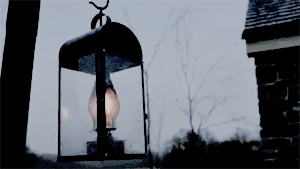



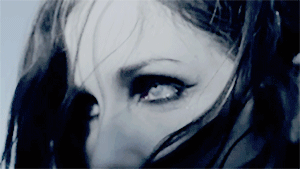

women of myth & folklore [4/?] ↣ witches
oooooooh...must be the season of the witch
#witch aesthetic#witch#witches#witchcraft#witchy#mythedit#mythologyedit#mythandfolkloreedit#myth edit#mythology edit#myth and folklore edit#myth#mythology#myth and folklore#mythology and folklore#women of myth and folklore#womaf#gif#gif*#mine
300 notes
·
View notes
Text
my first song
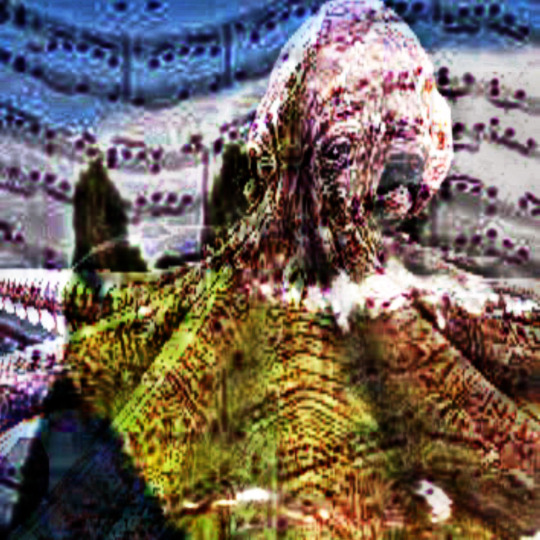
#my edit#underground#underground music#underground artist#support#my music#please#krakenblr#release the kraken#folktales#myths#mythology and folklore#folktale#folk horror#folklore#folk#nordic#nordic folklore#norway#naturecore#SoundCloud
1 note
·
View note
Text
Monster Art History: The Wendigo
You may be wondering why the wendigo, which has become very popular in pop culture over the last 10 years or so, is usually depicted in Western sources with a deer head. This appears nowhere in Native American traditions, despite the creature having lots of folkloric variations. The association of the wendigo with deer is 100% Western, 100% modern, and has a long, weird history.
Just in case you need a primer, the windigo or witiko is a supernatural being from the Algonquin speaking nations of the eastern American continent. It appears as an emaciated figure, sometimes giant, sometimes covered in ice, sometimes both. In many stories, they have a literal heart of ice. Windigos are manifestations of cannibalism and winter, and hunt, kill and eat people. Someone who resorts to cannibalism to survive, or otherwise abandons their community for personal gain, will become one of them. A few stories tell of someone being “cured” and turned back into a human, but usually the only cure is to kill the monster. In the last several decades, native writers have associated windigos with capitalism and deforestation as an extension of their selfishness. If you would like to know more about the properly Native windigo in context, I recommend Dangerous Spirits: The Windigo in Myth and History by Shawn Smallman.
The creature first came into horror fiction with Algernon Blackwood’s “The Wendigo”. Note the spelling, which would become the standard in horror, and generally in non-academic Western sources. In that story, it is not associated with cannibalism, but instead is a more generic “evil spirit of nature”. This wendigo stalks white people in the wilderness and turns a Native character into a new wendigo by seizing them and flying with them into the sky. This definitely better fits fears about non white people, fears about nature, and how the one is closer to the other than “civilized” people. Its description in the story is vague (the most we get is that it has burned its feet away by running into the sky). But when the story appeared in Weird Tales in the 1930s, Virgil Finlay illustrated it like this, the first antlered wendigo I know of.

This story was ripped off by August Derleth, a prominent Weird author in the 1940s and the main popularizer of HP Lovecraft. In his Cthulhu Mythos stories, he introduces Ithaqua the Wind Walker, which is an alien version of Blackwood’s monster. This fits into Derleth’s vision of the gods and monsters of HP Lovecraft falling into the four classical elements, with Ithaqua being invented to represent Air. Ithaqua is usually depicted as an icy, emaciated giant, so ironically is one of the more accurate wendigos to Indigeonous beliefs in pop culture.
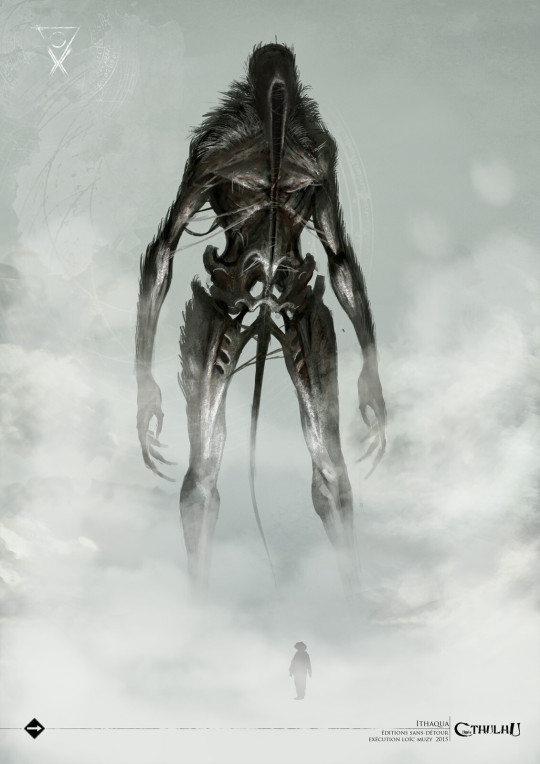
Image from a recent French edition of Call of Cthulhu RPG, by Loic Muzy
In Pet Sematary, Stephen King uses a wendigo as the reason for why the titular cemetery is cursed. This is an update of the classic racist trope of the “Indian Burial Ground”, except this time what gets buried there comes back animalistic and evil. The racist implications of that are pretty apparent. This wendigo is seen briefly and has ram’s horns. It does not appear in the first film adaptation, but does in the more recent one... with deer horns instead, because those are trendy right now.
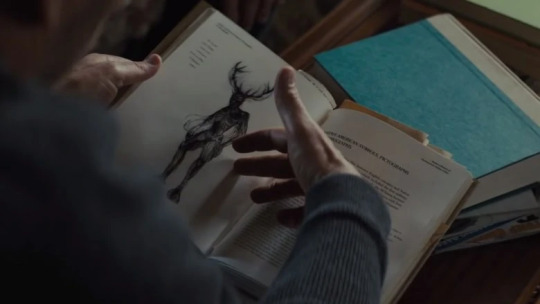
A good scholarly look at the real windigo versus the 20th century horror wendigo is “The Appropriation of the Windigo Spirit in Horror Literature” by Kallie Hunchman.
In the 1980s, a movie called Frostbiter: Wrath of the Wendigo was produced, but it wasn’t released until 1995 by Troma. From what I’ve read, it’s a pretty transparent ripoff of Evil Dead 2, with the characters being picked off in a haunted cabin with a zombie in the basement. The “twist” is that the origin of the horrors is a wendigo released by breaking a Christian demonology-style sacred circle. This wendigo is realized in stop motion animation, and has the most deer-like body yet.

A number of other independent horror movies in the 90s and 2000s used wendigos as a plot element. These follow the Blackwood/King approach of having the wendigo being something evil, ancient and Native American, reflecting white anxieties about living on stolen land more than Native anxieties about cannibalism and greed. Wendigo (2001) has the creature sicced on a white family when they hit a deer with their car. The Last Winter (2006) posits that global warming and fossil fuel extraction have unleashed the ghosts of dead animals, which are wendigo apparently, to revenge themselves on mankind. Which approaches the idea that greed is wendigo sickness, but I don’t think intentionally as a reference to modern Native literature. The “wendigo” in this movie are spectral moose and caribou.

The mainstream breakthrough of the deer-headed wendigo was in, appropriately enough for this blog, Pathfinder RPG. In “Spires of Xin-Shalast”, the last volume of Rise of the Runelords published in 2008, a wendigo is a major encounter. I suspect that either the author (Greg A. Vaughn), or one of the editorial staff had seen Frostbiter, as the setup involves a cabin haunted by dwarven cannibal ghosts who all killed and ate each other due to a wendigo’s influence. This wendigo is a hybrid of the Blackwood and Cree versions in terms of its MO: it is a cannibal ice spirit that wants to make more cannibals, and does so by abducting people and running off into the sky with them. Its design is the standard for what most Western artists depict wendigos as these days: an emaciated humanoid with the head and antlers of a deer (and the burned off feet of Algernon Blackwood, which are less common):
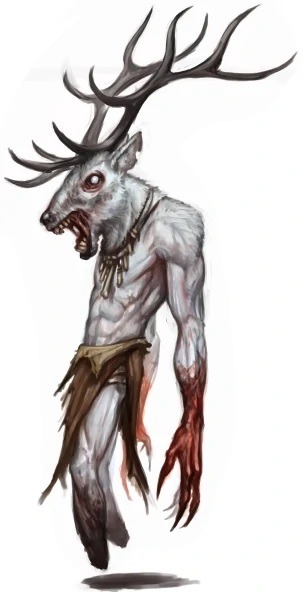
Image by Tyler Walpole, © Paizo Publishing
This wendigo definitely made a splash at the time; it was the first time I remember seeing a deer-headed wendigo, and art of that design started to become common. It pushed away previous wendigo depictions, which were typically werewolves (as French Canadian trappers had blended the concept with their own loup-garou, and Werewolf the Apocalypse had a whole faction of racist Native American “wendigos”) or shaggy and ape like (based more on the look of the Marvel Comics villain).
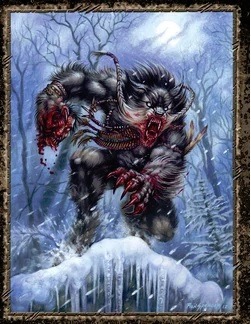
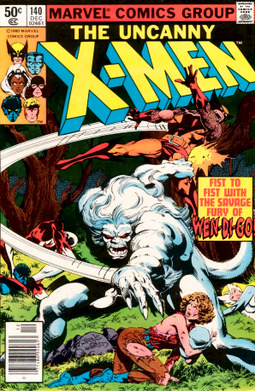
What turned wendigos from “folklore/horror monster” to “fandom blorbo” was Hannibal, which first aired in 2013. In that series, the first murder is a woman’s body impaled on a stag’s head, after which protagonist Will Graham has visions of a black stag, and a man with the antlers of a stag, representing murder, evil, and of course the cannibalistic murderer Hannibal Lecter.

Since Hannibal was super popular with the shipping fandom set, wendigo themed characters became popular in its wake, creating a wholly new way to culturally appropriate the wendigo. This was magnified by Over the Garden Wall, which came out in 2014, and its villain The Beast. The Beast is never called a wendigo, but is an antlered giant associated with winter, and so is commonly head-canoned as a wendigo and associated with them in fandom circles.

Which gets us to the modern day, where teenagers have misunderstood wendigo OCs, any character with antlers can be called a wendigo on the internet, and actual First Nations people with an actual cultural connection to the legend wish that people would just knock it off.
#and now you know#wendigo#windigo#witiko#creature design#art history#pathfinder rpg#algernon blackwood#august derleth#cthulhu mythos#stephen king#b movies#stop motion#hannibal#native american#first nations#cultural appropriation#long post
2K notes
·
View notes
Text


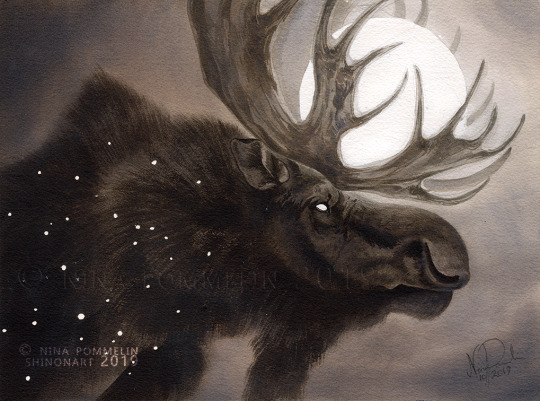
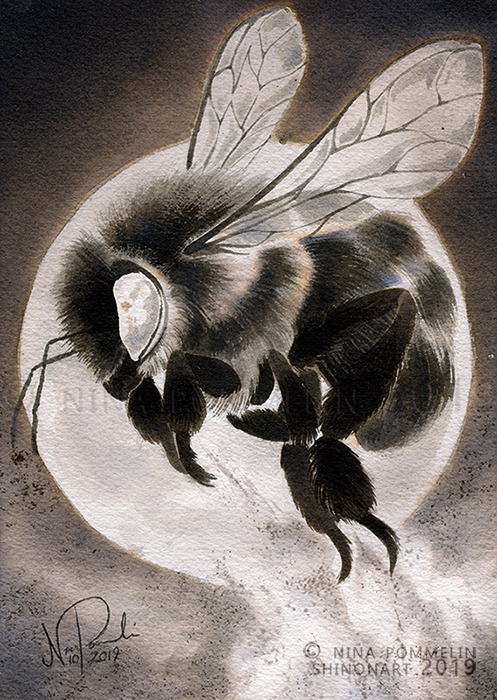



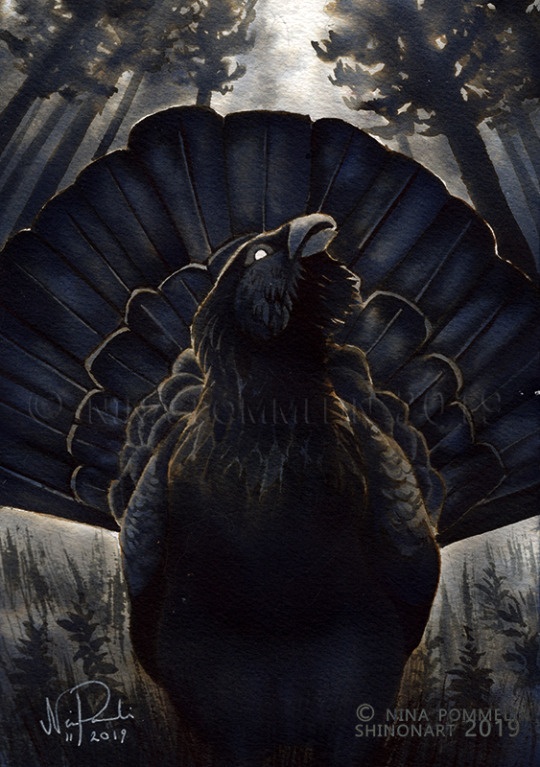
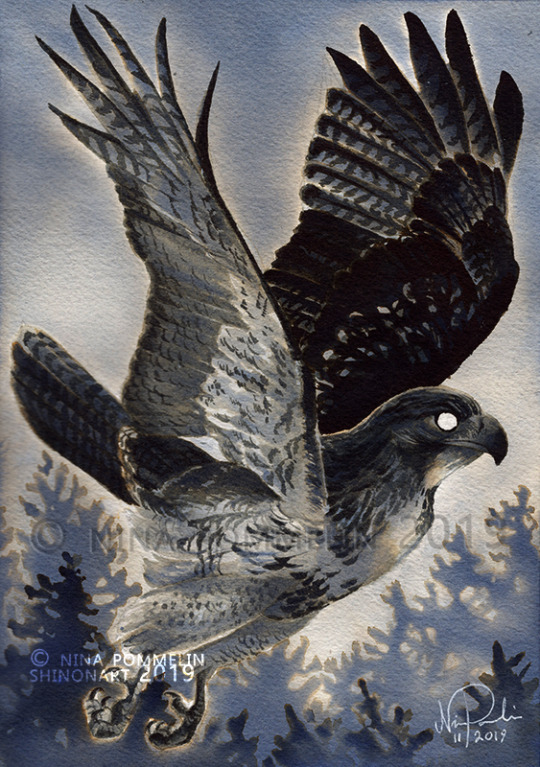
OLD GODS - Illustrations of Finnish Wildlife and Folklore is now available in both Finnish and English!
The newest edition of OLD GODS just arrived and is now available! It contains the text in both Finnish and English - all in the same book! The contents between the different editions aren't drastically different, but some adjustments had to be done to the layout to make all the text fit. The new edition has 76 pages total while the English onely one has 72 pages.
The new edition will take over once the English-only edition has sold out, and for this reason I have reduced the price of the English only edition.
OLD GODS is a collection of illustrations about Finnish wildlife and the myths and beliefs related to different animals. The artwork explores the mystical nature of many animals and portrays each as as ancient Finn could have seen them.
This book features 30+ ink illustrations, each accompanied by a written introduction to Finnish mythology and folklore related to the animals. The book also includes a step-by-step process for one of the paintings from start to finish.
Available on my Etsy and shipping worldwide (apart from some exceptions).
My shop and other places to find my art!
#old gods#art book#art zine#artbook#artbooks#traditional art#watercolor#artists on tumblr#animal art#wildlife art#mythology art#mythology#finnish mythology#folklore
175 notes
·
View notes
Text



360th Anniversary of Bohun's Death
17.02.1664 Ivan Bohun was executed in the Polish military camp


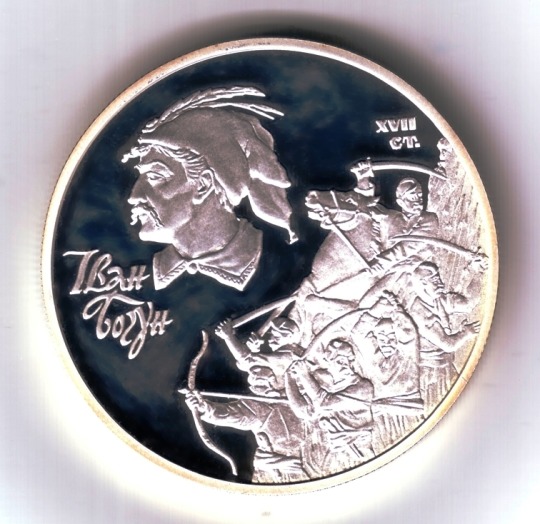
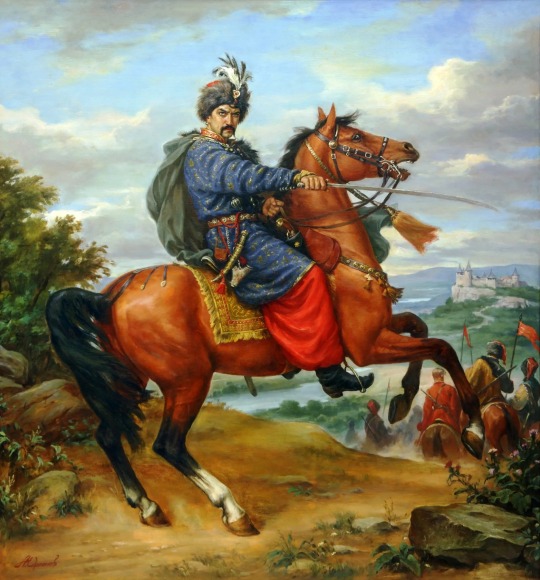
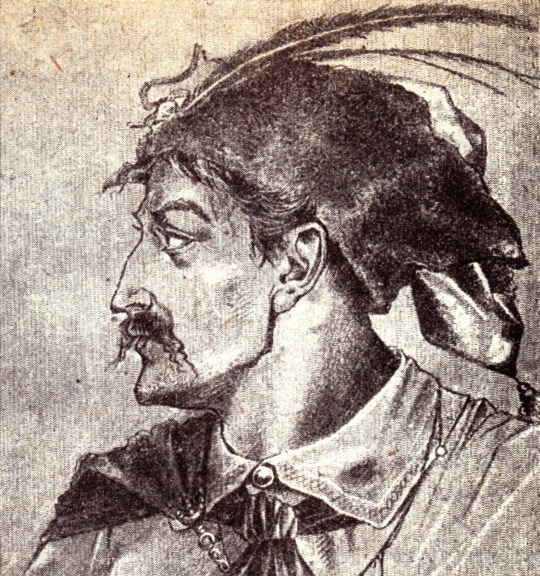

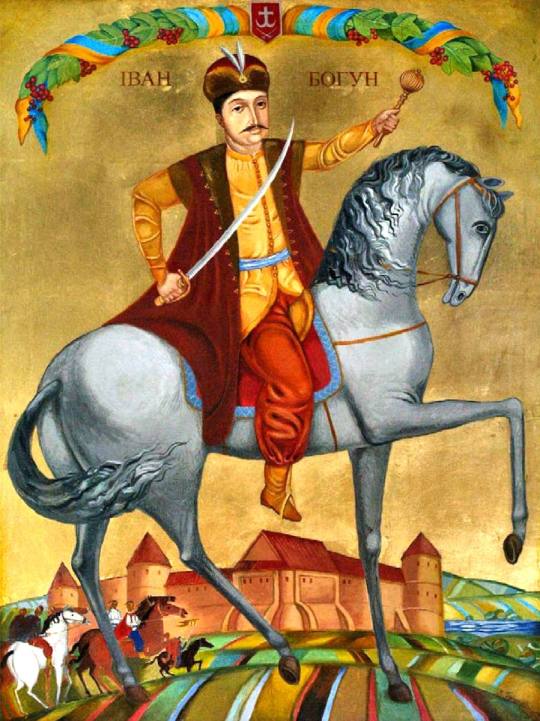
Ivan Bohun (Іван Богун) was a real person, an authentic Ukrainian Cossack hero from the mid-17th century and one of the most important Cossack commanders during the uprising of Bohdan Chmielnicki (Bohdan Khmelnytsky, Богдан Хмельницький), which started in 1648 ('Ukrainian Independence War').
As such, he has many diverse appearances in the Ukrainian culture and in the Polish culture (in literature, folklore, visual arts, music, opera, theater, cinema, etc.). Perhaps, the most famous worldwide (or just Tumblr-wide) of them all is the novel "With Fire and Sword" ("Ogniem i mieczem") by the Polish writer, Henryk Sienkiewicz, from 1883/1884. H. Sienkiewicz changed Bohun's name to Jurko, but described some of his authentic deeds, i.a. the role, he played during the battle of Beresteczko, 1651. The novel itself, as a part of the well-known "Trylogia" (which occupies an important place in the Polish culture), has many adaptations in art, theater, radio and cinema. The most famous of them is the Polish film from 1999, directed by Jerzy Hoffman. So...
Bohun's appearance in that film is not everything, in fact, it is only the tip of the iceberg of Bohun's myth. There is much more to explore and admire.
More information about artworks presented in this post you can find here:
It is a fan&didactic account, existing only for the Cossack Heroes glory and promoting Ukrainian heritage worldwide. Copyright belongs to the Artists/Museums.
#ivan bohun#jurko bohun#ogniem i mieczem#with fire and sword#trylogia#trylogia sienkiewicza#ukrainian history#cossacks#cossack heroes#ukrainian heritage#ukrainian culture#polish culture#ukrainian art#ukrainian literature#polish art#polish literature#trylogia sensem życia
133 notes
·
View notes
Note
you never read the lilith question from the first edition of lilith magazine you twisted presumptuous fraud and antisemite
So I'm probably giving you more attention than you deserve, but I also hate leaving someone who keeps repeatedly shouting something at me that's so wrong uncorrected.
You brought this up back in September (yes, this has been going on for that long), and at the time I hadn't read it so I assumed it supported your argument. I gave you the benefit of the doubt and trusted that it said what you said.
But here's the thing, I've since read it.
And it doesn't support what you're saying at all.
(Putting the rest under a cut since this gets long...)
So going to the actual piece we have to remember what "Lilith Magazine" is. It's a Jewish Feminist magazine writing primarily for a Jewish audience. Cantor-Zuckoff is talking about how Jewish women may want to look at her story differently. I don't find anything in there arguing for Lilith to be some pan-feminist icon for non-Jewish people. In fact, in the article Cantor-Zuckoff says:
What we have to explore are the uniquely Jewish aspects of the Lilith story, and how they relate to the Jewish experience, to Jewish history. After all, Jews lived among many different peoples and were subject to a bombardment of cultural and religious concepts and myths from all sides. What they accepted is important because it shows us what Jews perceived as necessary and appropriate to Jewish life and its continuity. How they transmuted what they accepted is also significant for this reason.
The account of Lilith’s revolt in the Alphabet is, to the best of my knowledge, intrinsically Jewish; no non-Jewish source tells of a female struggle for equality or gives it as a reason for the vengeful behavior of a female demon. This is especially important to us in exploring how the Lilith myth connects with our unique history.
The only comments about universality in the piece are when Cantor-Zuckoff says that there are stories with some similarities in other cultures just prior to those last two paragraphs:
These legends of Lilith-as-demon, the vengeful female witch, are, of course, not unique to Jewish culture and tradition. Many scholars theorize that vengeful female deities or demons, like the Greek hecatae, represent the vestiges of the dying Matriarchy or are an attempt by men to discredit the Matriarchy.
What Cantor-Zuckoff is arguing here is that there are myths in other cultures that have been influenced by patriarchy and serve some similar functions. This is not an argument for other people using Lilith, only that there are elements she shares. To claim they're the same though is bizarre, as you wouldn't claim that, say, Kinich Ahau and Helios are the same god just because they're both associated with the sun.
I think this really goes back to the fact that you've started with a conclusion and just reject anything that contradicts it. You really want it to be true. What I have said from the start is that Lilith is a figure who is unique to Jewish folklore. I backed this up with with the evidence we find in the historical record. I debunked the supposed "non-Jewish Lilith" sources.
And I said listen to Jewish people about what's okay or not okay to use from their culture, as they are a closed ethnoreligion, and not listening to them would make someone an asshole. You've been having a bizarre tantrum at me for like half a year now, and it's getting sad.
I don't know why you seem to care that I, a random person you will never meet, thinks you're being an asshole, but this has to stop.
(Context Note: For anyone who is seeing this post first in this ongoing "conversation" -- this anon has been harassing me for months because I dared say in my podcast that Lilith is a figure who comes exclusively from Jewish folklore, and that members of the Modern Witchcraft Movement should listen to Jewish people when they ask us not to appropriate her. That's right -- my saying "listen to Jewish people" is apparently an antisemitic act.)
59 notes
·
View notes
Text
Welcome to the Best Fictional Plant Tourney!
A WHILE ago someone sent an ask to @namedafterflowerstournament asking if they'd consider a 'best fictional plant/flower' tournament, and they said it'd be cool for someone else to do. After much sitting around to see if someone else would do it (and if you HAVE done it and I missed it im so sorry!!!!) I've decided to be that person >:)
RULES
Any kind of plant is allowed and because I'm feeling silly, I'll allow mushrooms. Trees, flowers, berries, fruits, veg, ferns, mushrooms, whatever
My only media restriction is no Harr/y Po/tter, don't worry she didn't actually invent anything so you can submit mandrakes from other properties. Myth/folklore is ENCOURAGED!!!
Sentient plants are ALLOWED, including SOME Pokemon. Oddish is def allowed cause he's a lil radish w leggies, walking mushrooms from dungeon meshi are allowed, Pokemon like dhelmise and decidueye not so much, some of these may go to prelim polls if im not sure.
EDIT: by fictional plants I mean plants that aren't found in the real world. Inspired and based on real plants is fine, ie endura carrots, maxim tomatoes, nilotpala lotus, but if it's like, beauty and the beast rose, that's just a rose, sorry for any confusion
EDIT for the EDIT: Real world plants with like. their own magical abilities in a series, ie vervain in the vampire diaries, wolfsbane in folklore, WILL be allowed. Exceptions might happen if i think it's funny :)
I've not thought about time limits/bracket count I just miss having something to Organise and I want to make my little lists and graphics again :)
Submission Link Here
for visibility @tournamentdirectory @tournament-announcer @bestvegetablepoll
63 notes
·
View notes
Text
writeblr introduction!

About Me
Hey, I'm Laney! I'd love to become more active in the writing community and find some writer friends. I love reading about everyone's ideas, and I'm always happy to beta read if anyone is looking for feedback! I'm currently a reporter, but have a passion for creative writing and editing. Some of my other interests include evolutionary biology, Greek mythology, and all forms of art.
About My Writing
Although I'm still trying to find my niche and what I enjoy writing, I'm currently working in the genres of literary fiction, fantasy, and gothic horror. I'm especially inspired by mythology and folklore, finding magic and significance in the mundane, and the diversity of the human experience.
Writing tag: #my writing
Current WIPs
Choking on Sea Salt - wip intro, chapter 1, chapter 2 part one, chapter 2 part two
tag: #choking on sea salt
In the same vein as the Southern Gothic subgenre, this novel is inspired by the idea of Coastal Gothic. In a remote coastal town, a young journalist finds herself unraveling the town's foggy history and ever-growing mysteries -- why are there so few women, why is it forbidden to walk along the beaches or sail in the waters, and what is the haunting song whistling through her windows each night?
Acrylic Body (tag: #acrylic body)
Upon the passing of an eccentric and reclusive painter, his artwork is left without a keeper and lies abandoned for years. Eventually, his home is cleaned out and his paintings are sold at auction. Through the eyes of one of his paintings, we view the lives of those whose hands she is passed through.
(untitled) (tag: #lysandra)
Ovid's Metamorphoses detailed the devotion of Persephone's handmaidens, and their transformation into winged sirens to pursue the goddess. This retells Persephone's myth from the perspective of Lysandra, a nymph-turned-siren who would travel to the ends of the Earth for her maiden.
I'd love to find some other writeblrs to follow so feel free to comment if you think our interests may align! + feel free to reach out to me if you ever want to chat about writing or want another pair of eyes on your wip!
<3
#choking on sea salt#acrylic body#lysandra#writing#creative writing#writeblr#my writing#writer#original writing#fiction#writeblr things#writeblr intro#writeblr community#writeblr introduction#fantasy writing#greek retelling
185 notes
·
View notes
Text







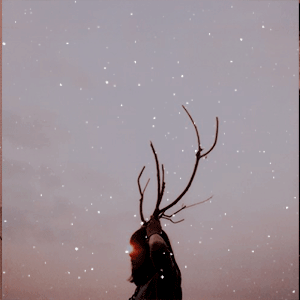

women of myth & folklore [3/?] ↣ deer woman, indigenous american protector of women
you with the dark curls, you with the watercolor eyes, you who bears all her teeth when she smiles...
#deer woman#indigenous myth#indigenous folklore#indigenous american myth#indigenous american folklore#mythedit#mythologyedit#folkloreandmythologyedit#folkloreandmythedit#folkloreedit#myth edit#mythology edit#folklore edit#womaf#women of myth and folklore#mine#moodboard#moodboard*
147 notes
·
View notes
Text
Do you guys want to see my mythology/cryptozoology book collection of course you do (specifically the non fiction ones, I also own like retellings and stuff, and i own The Illiad but i wasnt sure if it counted)


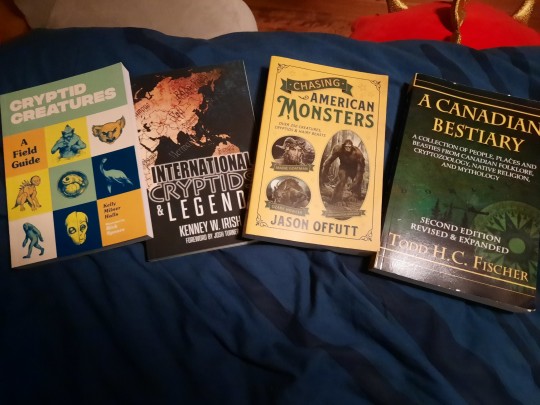
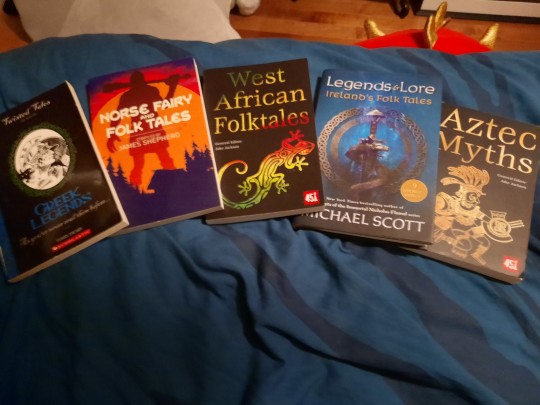
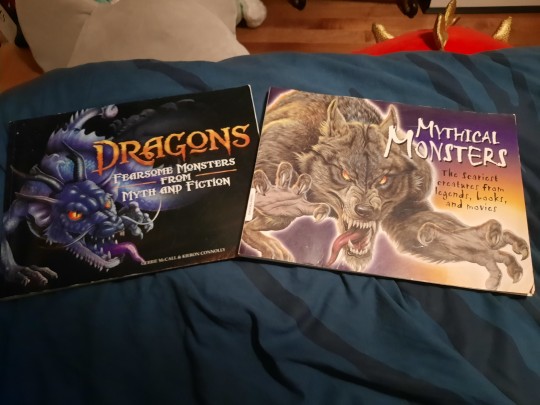


Complete list of books shown:
Greek and Roman Mythology by D.M. Field (I forgot I owned this tbh)
Treasury of Greek Mythology by Donna Jo Napoli
Mythology 75th Anniversary Illustrated Edition by Edith Hamilton
Halifax Haunts: Exploring the City's Spookiest Spaces by Steve Vernon
Haunted Harbours: Ghost Stories from Old Nova Scotia by Steve Vernon (I found both Steve Vernon books in the free library lol)
A Folk Tale Journey Through the Maritimes by Helen Creighton
Bluenose Ghosts by Helen Creighton (I dont even live in Halifax why do I have so many Halifax books sjsjdjej)
Cryptid Creatures: A Field Guide by Kelly Milner Halls
International Cryptids and Legends by Kenney W. Irish
Chasing American Monsters by Jason Offutt
A Canadian Bestiary by Todd H.C. Fischer
Twisted Tales: Greek Legends by Terry Deary
Norse Fairy and Folk Tales complied by James Shepherd
West African Folktales with general editor Jake Jackson
Legends and Lore: Ireland's Folk Tales by Michael Scott
Aztec Myths with general editor Jake Jackson
Dragons: Fearsome Monsters From Myth And Fiction by Gerrie McCall and Kieron Connolly (this book was literally my childhood I've had it since forever)
Mythical Monsters: The Scariest Creatures From Legends, Books and Movies with general editor Chris McNab
Grimm's Complete Fairy Tales by probably the Grimm Brothers but it's a fairly new edition so it doesn't credit them (fun fact I found this at a used stuff store for like 2$)
Black Dog Folklore by Mark Norman (I begged my parents for this for Christmas lol)
The Mythical Creatures Bible by Brenda Rosen
Tales of Ancient Egypt by Michael Rosen (I almost forgot this one that's by its in a picture by itself lmao)
#mythology#cryptozoology#greek mythology#folklore#ghost stories#cryptids#norse mythology#african mythology#aztec mythology#grimm fairy tales#english mythology
58 notes
·
View notes
Text
There’s something I find quite curious about the Captive Prince trilogy.
The lack, or paucity, of any references to religion. Or mythology or folklore. I find that a really interesting creative choice, because I think most readers feel the shapes of the fairytales and myths and beliefs that lie, like bones or the foundation of a building, under the surface of the story.
So let's discuss.
Firstly, belief systems. We know Akielos, much like the Ancient Greece it’s modelled on, has philosophers, even if we never hear about them in any detail.

We know there are Veretian and Akielon rituals regarding death. Aleron and Auguste are entombed, and so is Damen's faked body with Theomedes.
Akielon rituals are told to us in more detail via Nikandros:
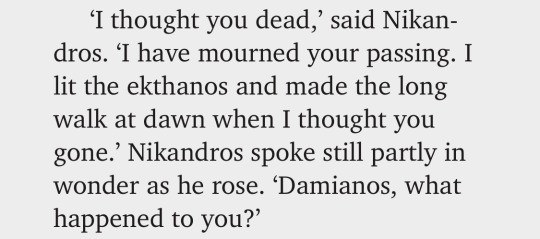
There is an Ancient Greek death ritual called the ekphora, a “ritual procession of the deceased’s body from where it had been laid out to the place of burial”. The prefix ek meant ‘out’ and phora ‘to carry’ so it literally denotes the carrying out of the body to be buried. I couldn't find 'ekthanos' as a real extant word, but with the same logic ekthanos means out + thanos- a word that can mean immortal or death depending on how you might interpret the etymology of it.
It sounds like Nikandros completed a mourning ritual and lit something (a votive lamp?) symbolically (perhaps it symbolises the leaving of the spirit, as that which removes or leads out the immortal soul from the body, hence ekthanos?). I would assume it was a funeral pyre if it weren't for the fact that Damen's body was interred (could it have been ashes that were interred? That would be safer if you're going to fake someone's death, but that's honestly me very much extrapolating from nothing. Also damn, Nikandros loves Damen. My heart honestly feels so warm about him. If that happened, and he stepped up to light the pyre when Kastor didn't, than he really is his real brother).
But for all this, there is no sense of an afterlife nor praying to deities.
More after the jump:
Edit: Unless you count Jokaste’s note to Damen, which seems to point to Greek ideas of metempsychosis/reincarnation.
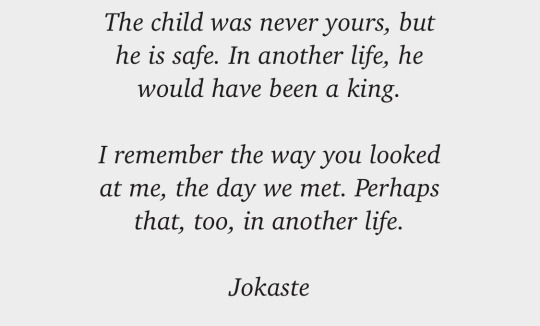
Regardless of that though there are no powerful institutions, no churches or temples, no religious figures to appease.
At first I thought there were no mentions of gods at all.
But there is.
Firstly in the very first description of Laurent in the baths:

And secondly, in the Akielon epic Erasmus sings:
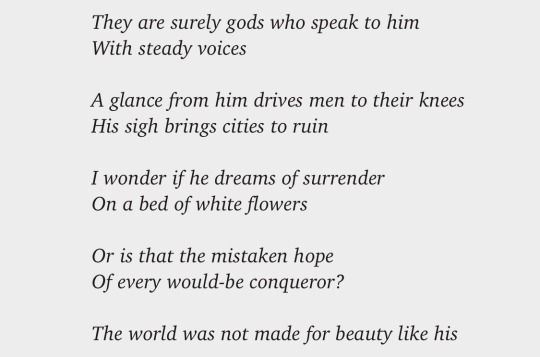
There’s also an unusual mention of Nereus who has a collection of statues in his garden. At first, because Nereus was a Greek god and because it felt faintly familiar, I took it for a classical allusion then swiftly realised on googling that it wasn’t. Or at least I don’t think so? Someone enlighten me, and I'll edit if I'm wrong.

So I think we can safely assume Akielos once had gods, but the religion died out perhaps (thought not due to the rise of Christianity). And their pantheon may have been pretty much been the Greek one as the influence might linger in names like Nereus, literally a god of the sea (and Damianos from Damia, a minor goddess of fertility, and Nikandros which has a root in Nike, goddess of victory…).
Edit: having now read The Training of Erasmus, Nereus is a slave owner, and his gardens a place for young pre-pubescent slaves to have their initial training. Sigh. Reading that story really is just heartbreaking.
Keeping to the topic I suppose (even with the lingering sense of disgust that ran through me while reading it) did he collect statues that were relics of the times before and keeps them in this garden? You can see statuary fitting into this strange rarified space for the most beautiful youths. It could be some echoing of Roman pleasure gardens which generally had that sort of statuary? Or is it a mirroring of Renaissance Italy where they tried to recreate Roman gardens, taking classical statues from ruins to restore and place in them? Who knows!
Without being explicit, Pacat makes it clear that beautiful Laurent is classical-statue-beautiful. Greek god beautiful. A Ganymede, perhaps or an Adonis. And slave beautiful, too.
And, of course, Damianos has so many parallels to Achilles, from his unparalleled strength and prowess on the battlefield, to his ability to strategise as if Athena is guiding him, to how he can become blinded by rage. The warrior-hero.
Ultimately, I guess what’s interesting is Pacat’s choices. It’s really hard to avoid any religious references in writing, as these allusions are baked in so deep to language. Damen being made a slave is called a “living hell”. Laurent presents an “angelic countenance”. Damen "prays" the training arena is empty so he can escape. Orlant thinks that Akielos sounds like "paradise". Interestingly, all those quotes are from Captive Prince, and it seems as if, as Pacat went along, she steered away more and more from any kind of religious reference.
I mean, I get wanting to steer clear of religion. After polytheistic religions came the monotheistic- and then suddenly we have a whole heap of reasons why homosexuality is a sin. If we cut that off, and there is no spread of Christianity across Europe, it seems we get the bisexual culture of Vere and Akielos and Patras.
[Edit: But also sex as a sin in general does not exist. The policing of heterosexual premarital sex came into being to control reproduction, which in turn helps secure bloodlines in a patriarchal society. And so Pacat very neatly invents another social taboo as a substitute; the fear of bastardry, which means no heterosexual premarital sex EVER, and thus bisexuality becomes the norm (Damen is against this seeing it as potentially leading to situational sexual behaviour which doesn’t feel right to him).]
I also think it may have distracted from Pacat’s pared down yet evocative writing style. And added layers of unnecessary complication as the Veretian version of the Church would be another tricky, powerful and corrupt institution for him to battle and there really is no room for that in the narrative.
And just as a mini musing of a postcript, we know Laurent reads illuminated manuscripts:

We know these surely can't be prayerbooks, so I think we can assume that they are histories and works of poetry and stories.
Stories of courtly love perhaps? Fables, legends and folklore? Old Akielon myths? I would love to know what he read.
There are two French/European stories that do come to mind when I think of Laurent.
Beauty and the Beast, of course, with Laurent-the-beautiful and Damen-the-'giant-animal', and the trope of the kind-hearted lover who thaws the heart of the one who has grown cold and cruel.
And Reynard the fox, the trickster figure, whose "sly amorality" is "sympathetic as it is needed for his survival".
And whose main antagonist is, of course, his uncle.
148 notes
·
View notes
Text
I didn’t really have a problem with this creator until now, she is the founder of Nuwa Hanfu and often does myth retellings while she does period-appropriate makeup.
It feels very .. Ignorant and lazy to be pronouncing Nezha’s name like this, especially for someone that claims they’re so well versed in not only Chinese folklore but the various styles of hanfu.
The retelling itself is accurate and I have no personal issues with it until the end of the video.
The way the retelling is structured makes it sound like this is the only thing Nezha is known for. That the only thing he is known for is his death and rebirth.
The story itself being a case of filial piety is up for much academic debate even today because of how unfilial Nezha was, willing to cut ties with the body his parents gave him and going to either Buddha or Taiyi Zhenren (this varies by edition and date of publication) for a new one. 10th century Buddhist monks would revere Nezha for choosing Buddha as a father instead, and readers of Canonization of the Gods would be shocked because Nezha’s origin myth doesn’t affect very much in the broader scale of the entire story; and it is surrounded by extreme cases of filial piety.
Yes, in modern society Nezha is a very popular character in cartoons meant for children to teach them lessons that also push a narrative of Nezha always having been filial to his parents. But he’s still regarded as an arrogant unfilial brat in media not designed for children and boasts a very impressive kill-count.
I just expected better from someone so many people regard as a good source of information.
#am i allowed to be upset about this?#li nezha#nezha#lmk nezha#monkie kid nezha#nezha 2019#nezha reborn#the legend of nezha#nezha lego monkie kid#third lotus prince
61 notes
·
View notes
Text

Calling ALL Helsa shippers!!!
@helsadiscord proudly presents Helsa Week 2023. The annual event to celebrate Helsa is coming this summer.
Save the dates! From 7 - 13 August 2023, we invite you to celebrate and appreciate Helsa in any form of fan creations. For every 2 days, there are a one-word prompt and one AU prompt that can be used interchangeably (or even combined!). We are looking forward to see your submissions! 😊
EVENTS
DAY 1 - 2 (7 - 8 August). INTERTWINED / MYTHS AU.
“Intertwined, like two boats tied together at the docks or the hands that are joined in camaraderie.” / Folklore, a retelling of the stories of the Gods and Goddesses (Norse, Greek, Celtic).
DAY 3 - 4 (9 - 10 August). MEMORIES / SPORTS AU.
“Memories - the good and the bad, treasured or forgotten - may have a way of returning.” / Olympic Games, Professional Athletes, E-Sports Tournaments.
DAY 5 - 6 (11 - 12 August). ENCHANTED / HISTORICAL AU.
“Enchanted, almost like a deer in the headlights; bewitched, as if a spell is befallen upon you.” / Medieval, Regency, Victorian, Vikings, American Old West.
DAY 7 (13 August). FREE.
Free space for your creativity! Let your imagination shine, do whatever your heart desires!
⎯⎯ ⎯⎯ ⎯⎯ ⎯⎯ ⎯⎯
When posting your work, please:
1. @helsaweekmasterlist
2. Tag #Helsa Week 2023, #HelsaWeek2023 and #HelsaWeek along with other appropriate tagging (fandom, characters, ship, spoilers, NSFW and content warnings).
Don’t be afraid to be creative, let inspiration flow! Create fanfiction, fanart, comics, edits, mood boards, headcanons, poems, essays, cosplay, meme, anything you fancy! If you have any questions, don’t hesitate to ask!
♥Have fun and Happy Helsa Week!♥
#helsa#helsa week 2023#elsa#queen elsa#hans#prince hans#frozen#elsa x hans#hans x elsa#iceburns#hansla#helsa week#helsaweek2023
80 notes
·
View notes
Text
Zestiria and Shinto

I think it’s very understated that Zestiria takes a lot after Shinto (compared to say, how people keep bringing up its Arthurian inspirations, despite those inspirations being superficial relatively), especially when it’s the essence of the game itself, but I suppose it’s easy for it to go over people’s heads if they don’t truly understand Shinto itself, which to be fair is a concept that is not equivalent at all to the religions widely known in the modern West.
As a preface, if I have to be quite honest, I’m not too fond of the localization of the terms in Zestiria. In isolation, “Shepherd” is a fine translation of “導師”, they both more or less mean a person who guides, though I’m not sure how much of that idea the word manages to get across. However, coupled with “天族” being localized as “seraphim”, the game lore becomes connotated with Biblical implications, which is unnecessary and not at all what is intended, though I’d have been hard pressed myself if I were tasked to localize these terms in a way that could convey the original intent in English, but that’s not the point. The point is, I believe this loss in translation contributes to the misunderstanding, and besides, despite what you might think, the seraphim are not angelic beings, especially of the Christian kind.
With that out of the way, I would also like to clear up something else: religions and religiosity, as defined in the Western culture, do not readily apply to Shinto. It has no single founder, no canonical scriptures that are authoritative like the Bible, it has flexible moral code (or rather, it lacks a rigid moral code) due to its nature, and it is not at all a monolithic system; it’s not a unified system where the people who adhere to the faith proclaim themselves as Shintoists, because it doesn’t work that way. It is literally the “way of the kami” (神道) in that the term is used to reference the practice of worship of kami. It is not at all odd for modern Japanese people to practice this kami-worship and the rituals associated with it while also practicing Buddhism or even Christianity, for example.
The two essential, “sacred” texts of Shinto, Kojiki (古事記, literally “Records of Ancient Matters”) and Nihon Shoki (日本書紀, literally “Chronicles of Japan”), are basically history books (and they were commissioned to be compiled by the government), but they do not encompass everything there is to know about Shinto itself, since there are other books chronicling other kami as well, especially local ones. Even between the two books, mostly because of the differences in intended audience and purpose, there are naturally differences in details and interpretation of the ancient Japanese mythology, some even are contradictory (there are even differences in variants of Shoki accounts of the myth, so let alone Kojiki and Shoki). Also, I say history books (and they for the most part are history books indeed), but it is more apt to say that they are written chronicles of Japanese myths, legends, oral traditions, folklores, and such, but I would say Nihon Shoki is the more “objective” of the two. I think this part inspires Celestial Record as well as Lxi himgnowlot uz Yniitruh (or “The description of Glenwood” in English), the travel notes included as one of the special items in the LalaBit Collector’s Edition of the Japanese version of the game.
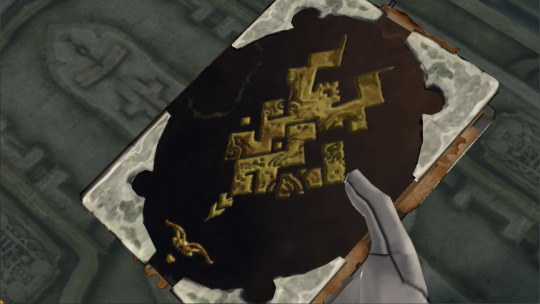
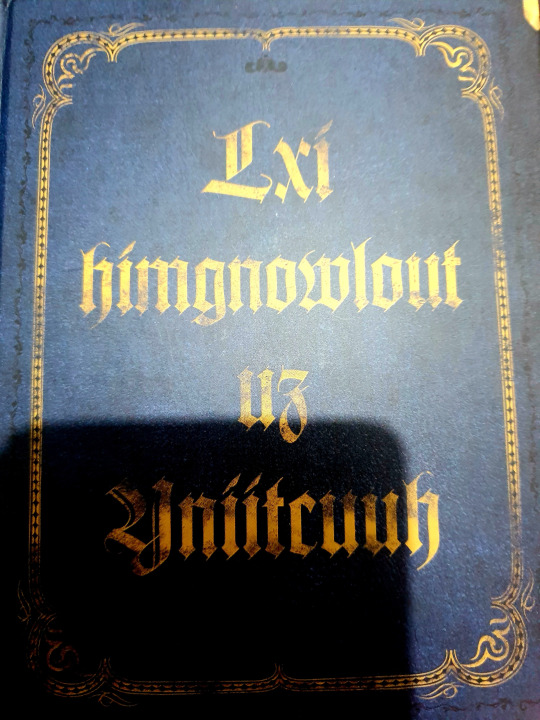

Already you can see how the historiography of Glenwood is influenced by Japanese historiography, because of the belief that has been there all along since the prehistoric times. The subjective interpretations of the situations or even origins that are not immediately knowable, especially, since both of these books are clearly written by humans (that fact isn’t hidden at all), make them feel more like they act as notes of the world, just like Kojiki and Nihon Shoki, and because of this subjective interpretation method, differences are bound to happen, even before getting to the differences of interpretations in individual readers. (By the way, the Japanese name for Celestial Record, 天遺見聞録, clearly implies this too, if translated a bit more literally, it means “the records of what is seen and heard as left behind in the Celestial.”)
Now, we get to the core of this, namely kami (神). Kami is often translated as simply “gods”, but this is, again, very misleading and not at all a good explanation of their nature. Kami, unlike the god(s) in other religions, do not come before or after the cosmos, they are the phenomena themselves and they are ubiquitous. A popular descriptor for them is “spirits or forces of nature” but even this is a simplification of what they really are. Kami describes the mind (心), an underlying principle (基本的原理), the divine to be worshipped (祭る), to be believed in (信じる), to be respected (崇める), to pray to (祈る), to be served (仕える), to be devoted (捧げる), to be given gratitude (感謝する), but most of all, kami possesses an eminent quality that is out of ordinary, that inspires the feeling of awe (畏怖) inside us all. To be in harmony with these awe-inspiring aspects of nature is to be conscious of the way of kami, and all phenomena are candidates for this designation, e.g., the sun, moon, mountains, or even great persons, heroes or leaders. However, to experience the kami presence of any one of these aspects of nature requires a pure and bright heart (清き明き心), which is an emotional, mental, and volitional condition that is not easily attained.
Here, I want to sidetrack to one of the above descriptors, that is, kami are to be worshipped (祭る). If you notice, it is the basic verb form of the word “festival” in Japanese, “祭り”. This is because one of the most crucial deeds toward kami in Japanese view is 祭る. The Japanese tend to be more religious when it comes to ceremonies than to the daily life. Worshipping kami in Japanese sense is different from other religions; whereas for some faith, the worshipping rite seems solemn and preoccupied, on the contrary, many Japanese worshipping ceremonies are very energetic and festive. Though the sacrament can be broken down into two parts: solemn ceremonial ritual and exuberant celebration, only the second part allows many people to participate more. In Zestiria, one of the biggest examples of this is the Sacred Blade Festival (聖剣祭).

But back to kami as beings. They are noble beings to be venerated, and there is a concept of Yaoyorozu no Kami (八百万の神, literally Eight-Million Kami) because there is an infinite number (eight million represents uncountable, just like how 8 as a number is often used to describe “infinity” in many cultures) and it is impossible to know them all (and it’s not like that uncountable number is static either... since humans can turn into kami and kami can inhabit any kind of object, that number naturally expands). Of course, with that many number, kami can vary from one another—they’ve been described as jinkakushin (人格神), or divine beings that have human-like qualities in that they have personalities and emotions of their own. This means that there are both benevolent kami and evil kami, so to speak. They can both bring blessings or harm to humans, and this duality means that kami are both revered and feared. Again, awe-inspiring aspects of nature. Which means Shinto as a religion isn’t exactly concerned with the afterlife like many religions, but with the nature itself, with the current life, as it is our world that is sacred. This is also true for the seraphim and the world in Zestiria.
Another term that is borrowed from Shinto is kegare (穢れ), which I usually translate to “taint” but in the context of localized Zestiria, it is known as malevolence. This, I feel, is another case of the localization causing even more misunderstanding than necessary; the kegare in Zestiria might not map 1:1 to the same concept in Shinto, but they are both fundamentally not a form of moral judgement, and whether the kegare itself is caused by a deliberate act, as for example in the case of a crime, or by an external event, such as illness or death, is secondary. As such, it is wrong to equate it to, say, Christian idea of sin, which malevolence, as a word that inherently suggests evil, kind of conveys to people. Kegare in Shinto is impermanent, as they can be remedied through purification. The concept of purity in Zestiria upholds the same quality being uphold by Shinto, namely, “真” which can be translated as “sincerity” but more literally, it means “truth.” Being true to yourself. This idea is reflected in the aforementioned “pure and bright heart” (“清き明き心”) since “pure and bright” in this case implies something that is transparent, that which is clean and clear, from the kanji themselves (to easily explain this more: 清 means “clear” and the Japanese word for transparent, for example, is 透明, which contains 明).

The Armatus (神依, kamui), as the highest power a Shepherd could have and described as the divine might (神威, which can also be read as kamui), is then, alikened to kamioroshi (神降ろし) in Shinto. Like the name implies (it literally means “descent of kami”), kamioroshi is a divine invocation held in that deity’s honor, to take possession of the one who invokes them. Since seraphim, who are based on kami, are forces of nature beyond mortal understanding, the Armatus again incites both reverence and fear of its powers.
Speaking of the seraphim being said to be beyond what humans could possibly understand, I believe this is partly why the true nature of them isn’t fully revealed. Details like how they’re born (or reborn), how they grow, what they actually are... these are meant to be mythical. We will never know, we can never know for sure. Humans tend to try to make sense of their surroundings, but there are just some things out there that will remain as mysteries to us no matter how much we try to uncover it.
(This applies as well to humans not knowing their own true nature... for example, the true nature of malevolence, said to be an irony of the contradictions of humans.)
――天族について詳しく教えてください。
山本 人から転生したという天族がいたり、いくつかの方則側はあきらかになっていますが、明確にこういう種族だよ、ということはできません。どちらかというと、神霊のような存在となっています。だから、天族たちは自分はこうなんですとか転生したんですと言っていますけど、実は何をどうしたらそうなるかという部分は非常にあいまいだったり、ケースバイケースだったりします。そういう、ルールで割り切れない部分を持った種族ですね。
――Please tell us about the seraphim.
YAMAMOTO: There are some seraphim who were reincarnated from humans, and some rules about it have been revealed, but it is not possible to say clearly what kind of race they are. If anything, they are more like divine spirits. That’s why, the seraphim are saying that they are like this or that they are reincarnated, but the truth is, the part about what to do to become like that can be very ambiguous or in a case-by-case basis. They are the kind of race that cannot be comprehended by mere rules.
――天族の成長は自身の思いにかかわってくるのですか?
山本 自分の力の強い時期まで成長するんじゃないかという推測はありますが、ここも実は法則性はないんです。
――Is the growth of seraphim related to their own thoughts?
YAMAMOTO: There is a conjecture that they will grow until they reach the peak of their own strength, but again, there are really no strict rules here.
And I understand how and why this would leave some people dissatisfied because they want to fully understand the inner workings of a fictional world to make sense of it, however at the same time, I think it’s not necessary for us to try pin down every detail to understand something holistically. Sometimes it’s fine to just feel it, to leave some things to our imagination even if it might seem hard to make sense of, but part of being humans is to appreciate beauty in these contradictions as well. Not everything has to have [human-knowable] rhyme or reason to it.
(While we’re at this, I would like to express a very subjective, very personal, and admittedly very biased opinion of mine: This is why I wish people would’ve been more appreciative of Zestiria as a standalone separate from Berseria, and not rely on Berseria to fill in the blanks of Zestiria. Berseria, to me, has a very distinct feel from Zestiria in the context of this, as the malakhim of Berseria don’t inspire the awe in me like how the seraphim are depicted in Zestiria. Everything in Zestiria that is supposed to evoke that sense of wonder, like the seraphim, Armatus, etc. is gone in Berseria, which tries to explain everything in a really mechanical, almost scientific way, and that beats the purpose of Zestiria with all its fantastical spirituality and vagueness that a lot of people hate but I personally really adore. And sometimes they can’t even do that right, as a lot of Berseria explanations directly contradict what is shown in Zestiria. This is also why I think intricate, overexplained worldbuilding is overrated; some details are better left hidden, imo. Even hidden is plain sight is better than directly explaining it to us.)
Of course, I can’t adequately explain everything that is inspired by Shinto in Zestiria, and this barely scratches the surface (and that’s not counting inspirations from other myths, religions, and philosophies like Arthurian Legend, Buddhism, Daoism, etc. that are also in the game), but I hope this can give you the rough idea! Zestiria, I feel, is a game that puts a great emphasis on the wonders of its world—it’s not that everything that we know is all there is to the world, and this world has lived for a long time, unimaginably so by humans, so there’s bound to be some things that we just don’t know, we just can’t know, but have been there all along, and you can feel them even if most of the times you can’t put it into definite words. If you think about how vast the world is, and that it keeps evolving in its vast history, some unrecorded... we become more aware and appreciative of how beautiful the world really is. And in the case of Zestiria, this is reflected in the curiosity of Sorey, the protagonist, of the world, along with its history, that opens up before him. The legends have and will always live, and someday they will become “hope.”
#tales of#tales of zestiria#mino rambles#REALLY long post#basically my zestiria lovemail#as a side note: i do think them including arthurian legend inspirations is their way to evoke similar feel to this to western people#what the devs probably don't know is that myths work and feel differently in different parts of the world#so it probably isn't effective in bringing out that sense of wonder#since hase and baba expressed concerns about not wanting zestiria to be TOO japanese#mino talks zesty
99 notes
·
View notes
Text
@tired-reader-writer
Maybe not something you'll feel like reading right away, but here's something I got thoroughly distracted by when doing research for fic recently: the book Zoroastrians: Their Religious Beliefs and Practices by Mary Boyce (link goes to a PDF of the entire thing). It's fascinating in its own right, but definitely also a great resource for those looking for worldbuilding inspiration for ArSen fic!
Also The Wild Rue of Persia: Magic, Myth and Folklore in Iran by Bess Donaldson. I would gladly have bought a copy of the reprinted edition of this if it wasn't so fucking expensive! But you can read the original online thanks to the Internet Archive. There's so much good stuff in here! Just look at the description and chapter titles listed here!
And while I'm at it, I'm just going to drop another couple of links that might be of use/interest too.
Plant Diversity of Hyrcanian Relict Forests
Long live the King… of Kings! Accession ritual in ancient Persia
41 notes
·
View notes
Text
Announcement: Folklore Pokemon
Hello, Rotomblr👋. I wanted to announce something I'm doing!
Many people don't know of the pokemon that appear in folklore. Many of the books and Fairy tales we read as children showed us Pokemon that are around today with not many edits. But did you know that many myths and legends contain fabled pokemon that only appear in these myths. I'm someone who studies these myths, and I wanted to share them! Every once in a while, I will post pokemon that only appear in fables and talk about their myths and potential origins and where they stem from.
Ooc; Based on this post. Basically, I'm making mythical pokemon that are actually myths and appear in old stories.
#runa talks#folklore pokemon#pokemon folklore#pokeblogging#pokeblog#rotomblr#pokemon#irl pokemon#rotumblr#pokemon irl#pokeblog rp#pokemon history#pokeblogging roleplay#pokemedia#pokeposting
34 notes
·
View notes